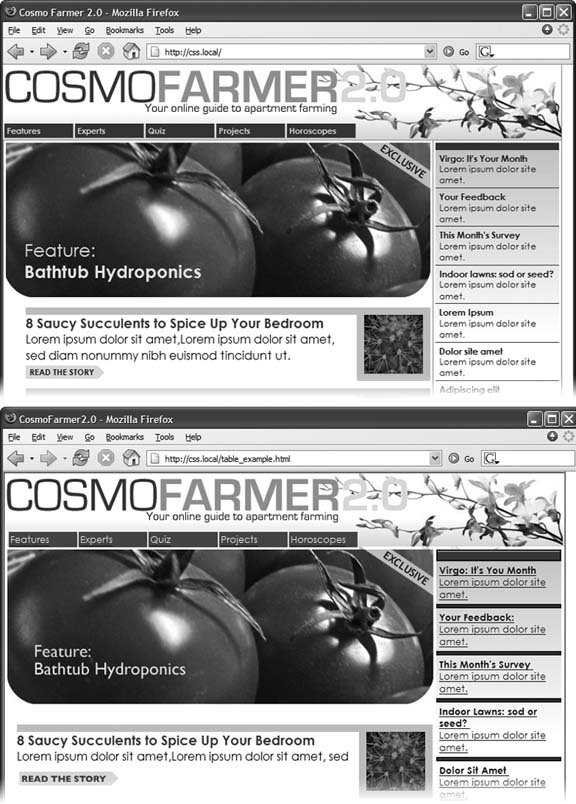To get the most out of CSS, your HTML code needs to provide a solid, well-built foundation. This chapter shows you how to write better, more CSS-friendly HTML. The good news is that when you use CSS throughout your site, HTML actually becomes easier to write. You no longer need to worry about trying to turn HTML into the design maven it was never intended to be; instead, CSS offers all the graphic design touches you'll likely ever want. And your job becomes simpler since HTML pages written to work with CSS require less code, less typing, and are easier to create. They'll also download faster—a welcome bonus your site's visitors will appreciate (see Figure 1-1).
As discussed in the Introduction, HTML and its successor, XHTML, provide the foundation for every page you encounter on the World Wide Web. When you add CSS into the mix, the way you use HTML changes. Say goodbye to repurposing awkward HTML tags merely to achieve certain visual effects. Some HTML tags and attributes—like the <font> tag—you can forget completely. The following sections explain why.
Note
Throughout this chapter, everything you read about HTML applies equally to XHTML. There are as many variants of HTML and XHTML as there are colors in the rainbow, though, and in the end you must pick a type and make sure your Web page identifies which one you're using. Otherwise, your visitors' browsers may gunk up your painfully crafted page. You'll learn how to tell CSS which flavor of HTML/ XHTML you're using later in this chapter.
Figure 1-1. CSS-driven Web design makes writing HTML easier. The two designs pictured here look similar, but the top page is styled completely with CSS, while the bottom page uses only HTML. The size of the HTML file for the top page is only 4k, while the HTML-only page is nearly 4 times that size at 14k. The HTML-only approach requires a lot more code to achieve nearly the same visual effects: 213 to 71 lines of HTML code for the CSS version.
When a bunch of scientists created the Web to help share and keep track of technical documentation, nobody called in the graphic designers. All the scientists needed HTML to do was to clearly structure information for easy comprehension. For example, the <h1> tag indicates an important headline, while the <h2> tag represents a lesser heading, usually a subheading of the <h1> tag. Another favorite, the <ol> (ordered list) tag, creates a numbered list for things like "Top 10 reasons not to play with jellyfish."
But as soon as people besides scientists started using HTML, they wanted their Web pages to look good. So Web designers started to use tags to control appearance rather than structure information. For example, you can use the <blockquote> tag (intended for material that's quoted from another source) on any text that you want to indent a little bit. You can use heading tags to make any text bigger and bolder—regardless of whether it functions as a heading.
In an even more elaborate workaround, designers learned how to use the <table> tag to create columns of text, and to accurately place pictures and text on a page. Unfortunately, since that tag was intended to display spreadsheet-like data—research results, train schedules, and so on—designers had to get creative by using the <table> tag in unusual ways, sometimes nesting a table within a table within a table in order to make their pages look good.
Meanwhile, browser makers introduced new tags and attributes for the specific purpose of making a page look better. The <font> tag, for example, lets you specify a font color, typeface, and one of seven different sizes. (If you're keeping score at home, that's about 100 fewer sizes than you can get with, say, Microsoft Word.)
Finally, when designers couldn't get exactly what they wanted, they often resorted to using graphics. For example, they'd use a very large graphic as background for a Web page or slice it up into smaller graphic files and piece them back together inside tables to recreate the original image.
While all of the above techniques—using tags in creative ways, taking advantage of design-specific tag attributes, and making extensive use of graphics—provide design control over your pages, they also add a lot of additional HTML code (and more wrinkles to your forehead than a lifetime in the sun).
No matter what content your Web page holds—the fishing season calendar, driving directions to the nearest IKEA, or pictures from your kid's last birthday party—it's the page's design that makes it look like either a professional enterprise or a part-timer's hobby. Good design enhances the message of your site, helps visitors find what they're looking for and determines how the rest of the world sees your Web site. That's why Web designers went through the contortions described in the previous section to force HTML to look good. By taking on those design duties, CSS lets HTML go back to doing what it does best—structure content (more on what that means in a moment).
Using HTML to control the look of text and other Web page elements is obsolete. Don't worry if HTML's <h1> tag is too big for your taste or bulleted lists aren't spaced just right. You can take care of that later using CSS. Instead, think of HTML as a method of adding structure to the content you want up on the Web. Use HTML to organize your content, and CSS to make that content look great.
Get CSS: The Missing Manual now with the O’Reilly learning platform.
O’Reilly members experience books, live events, courses curated by job role, and more from O’Reilly and nearly 200 top publishers.


